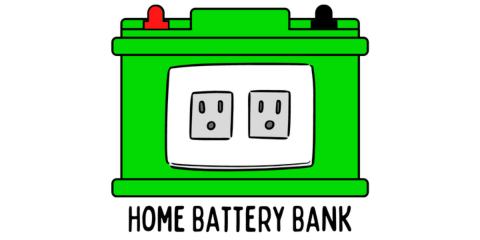Let’s face it, you were just having way too much fun listening to your favorite podcast with your headphones to notice that your lawn mower was running out of fuel, weren’t you? After coming to a complete stop, you add more fuel.
Except now, your lawn mower won’t start. It’s trying to turn over if it’s a rider, and you can tell its trying to work when you pull the cord on a push mower, but it just won’t fire up.
Go ahead and set aside the frustration because we’re going to get you back in business in a few minutes.
Generally, both a push lawn mower and a riding lawn mower will fail to start after having run out of gas if either the fuel being added is stale or if there is air or debris trapped in the fuel lines. Stale fuel will not combust and air in the fuel lines will not allow gas to flow to the carburetor.
You can consult the table below for a quick fix, but if you need something a little more information on how to do something, you can proceed to your type of mower in the article and you can also find a quick video (if you’re reading this early after posting, then it’s on its way!) that I made the will guide you through the issue.
| Lawn Mower Type | Likely Problem | How to Fix |
|---|---|---|
| Push Lawn Mower | Newly added gasoline is stale and won’t combust | Pinch off fuel line running to carburetor. Disconnect fuel line from carburetor and place the fuel line in a jar. Remove the pinch and allow the stale fuel to drain. Empty carburetor bowl of stale fuel. Reconnect fuel line and fill with fresh fuel. |
| Riding Lawn Mower (Lawn Tractor) | Stale Fuel Or Air Trapped in Fuel Lines | To remove stale fuel, pump out the fuel tank with a battery pump, disconnect the fuel line at the carburetor and blow out the tank with an air compressor or by mouth. Be sure to drain the carburetor bowl as well. To remove air, blow into the fuel tank by mouth or with short bursts with an air compressor. (See article for more safety details in the second section) |
Push Mower Won’t Start After Running Out of Gas
When I’ve serviced push mowers over the last 7 years, I have found that stale fuel is a major culprit for an engine failing to run — especially if it was just running a few minutes prior and needed a refill after having run out of gas.
Gasoline is generally pretty clear but turns to a Mountain Dew color as it oxidizes and loses its combustible properties.
It’s an honest mistake to use up the last bit of gas in a gas can mow the lawn, run out of gas, and reach for another gas can where you’re not quite sure when you last filled it.
Was it this year? A few months ago? Two years ago?!
Regular E10 gasoline will start to degrade in as little as a month without a fuel stabilizer and you’ll likely see a significant performance decrease after 3 months.
Ethanol free gasoline (marine gas) will start to degrade after 3 months or so and you’ll probably see significant performance loss after 4-6 months.
To prevent this from ever happening again, buy yourself a bottle of SeaFoam (Amazon). You simply add 1 fluid ounce per gallon in your gas cans, screw on the nozzle, shake the gas for a second, and then it will last for 2 years without a problem. I have personally tested this and the two year claim on the bottle is accurate.
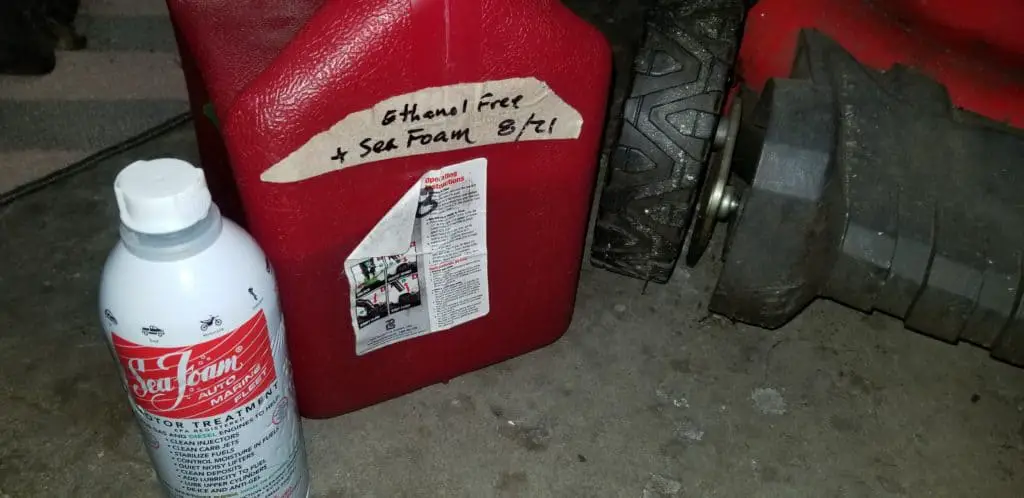
If you think you’ve added stale fuel to your tank, simply disconnect the fuel line from the carburetor and let the stale fuel drain into a jar or container. Contact your local hazardous waste materials agency and find out how to best dispose of it. If the fuel is less than a year old, you should easily be able to add a quart or so to your car on a full gas tank to dilute it an use it up.
Don’t forget to drain the small amount of stale fuel in the carburetor bowl as well.
In the last 7 years though, I haven’t had one push mower that wouldn’t start because of air or debris in the fuel lines. I’m not saying that it can’t happen, but the fuel line from the tank to the carburetor is so short and so direct that not much can go wrong.
Still, it is possible and worth checking if you know that your engine was just running, it ran out of gas, and the new fuel is not stale.
To do this, pinch off the fuel line between the tank and the carburetor. Then remove the fuel line from the carburetor.
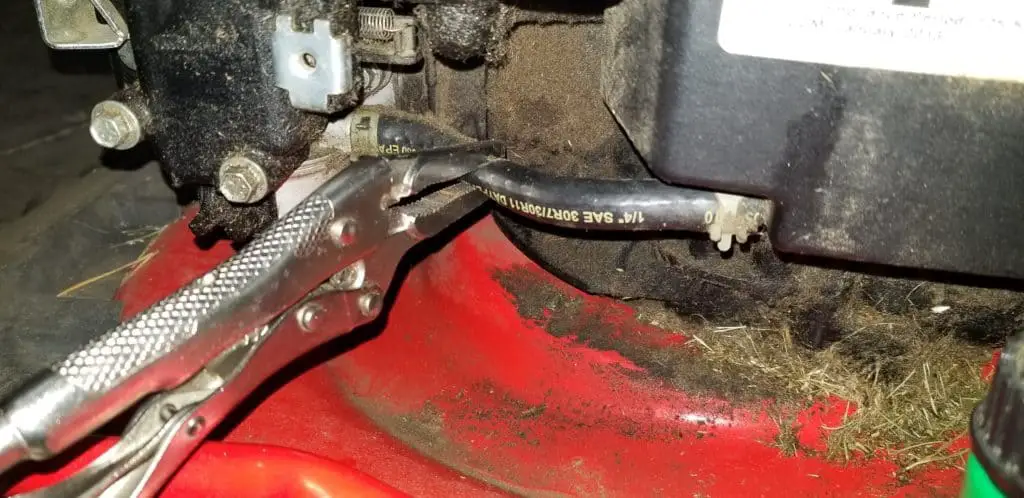
Release the pinch for just a second to see if gas flows out of the hose. If it does, then pinch it off again.
With the hose pinched off, drain the gas (if there is any) from the carburetor bowl from the drain screw (if yours has one). If yours doesn’t, like mine, go ahead and remove the bottom bolt to remove the bowl. Clean any debris from the bottom of the bowl.
If you have a lawn mower that has a carburetor that looks like the picture above (Snapper), then the next two steps are optional. But since we already have the bowl off, it’s a good practice.
First take a can of carburetor spray cleaner with the small red straw that comes with it and squirt a few shots into the main tube that runs up the carburetor (see the picture) to clear out any possible debris. It’ll be a tight squeeze and you’ll have to bend the straw a little bit. The main jet might be up there, or it may be the actual bolt that holds the bowl onto the carburetor (see the second picture).
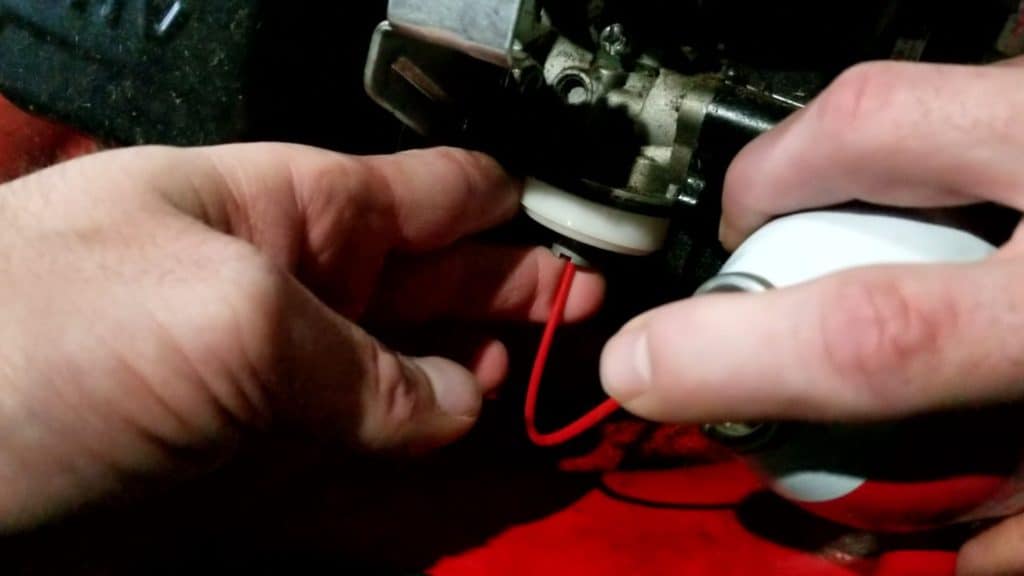
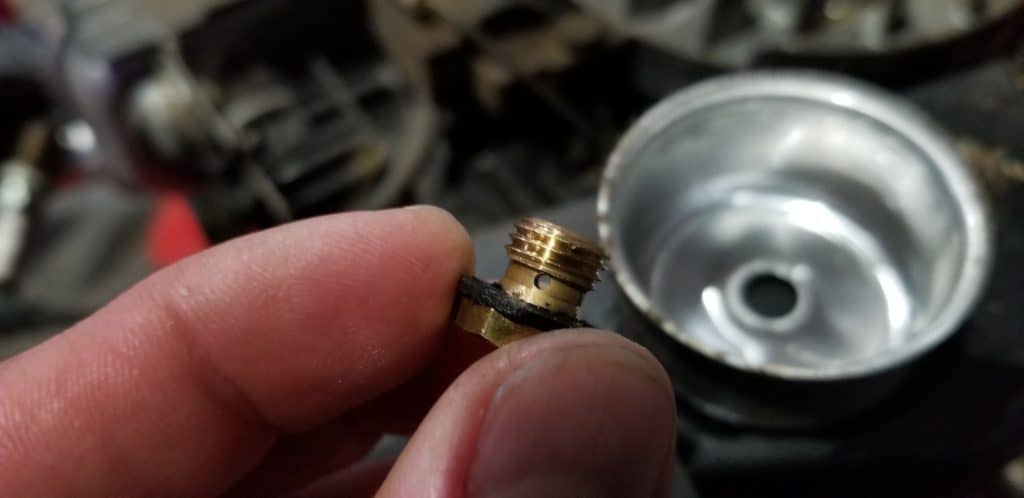
Secondly, since the fuel line is disconnected from the carburetor, go ahead and squirt a few shots of carburetor cleaner in to the connection point of the carburetor where the fuel line hooked up (fuel inlet). The fuel should spray out the bottom of the carburetor if the float is dropped down (which it should be with the bowl removed).
Some carburetors have a small screen in there between the float needle seat and where you connect the fuel line. If the screen got caked with debris that was floating around at the bottom of your tank and made its way down the line with the last of the gas on your first tank, then this will keep gas from entering the carburetor.
If that’s the case, you’ll have to remove the air filter assembly and the carburetor. You’ll then need to remove the float and squirt carb cleaner back through the float needle seat and blow the debris out of the fuel inlet.
Some fuel inlets can be removed with vice grips by pulling and twisting to access the dirty screen as well.
Now, back to what we were doing as far as checking gas flow.
With the gas line still pinched and the bowl of the carburetor still off, go ahead and reconnect the fuel line to the carburetor. Release the pinch for a moment and see if gas starts flooding out of where the carburetor bowl should be.
If it does, that you know that you have fuel that is flowing properly and this isn’t your problem.
Again, I haven’t seen this be the issue before. In theory it’s possible, but I find that stale gas is the leading cause of a push mower failing to start after it has been refueled.
Riding Mower Won’t Start After Running Out of Gas
Riding mowers, on the other hand, have more of a chance from my experience of not starting due to air in the lines if you just rain out of gas and refueled.
The gas tank is often located in the back and there are several feet of hose that winds down to the engine. It’s much easier to get an air pocket blocking things.
Again though, make sure that you don’t have stale fuel added to the tank. If you do, either pump it out or disconnect the fuel line from the inline fuel filter and drain it out into the original gas can that had the stale fuel to begin with. Dispose of properly.
To prevent this from ever happening again, buy yourself a bottle of SeaFoam (Amazon). You simply add 1 fluid ounce per gallon in your gas cans, screw on the nozzle, shake the gas for a second, and then it will last for 2 years without a problem. I have personally tested this and the two year claim on the bottle is accurate.
If you know the fuel is good, we’re going to go ahead and try to remove the trapped air in the fuel line.
Most of these lawn tractors (at least all of them that I’ve worked on) are not gravity fed from the tank to the carburetor. There is a fuel pickup tube that sticks down from the top of the fuel tank to near the bottom, and fuel is sucked up through that tube and down to the carburetor via a vacuum fuel pump that is attached to the engine.
If we get too much air in the line, the process won’t work. It’s just like driving a hand-pump well down into the ground and expecting to get water when you start cycling the handle. Nothing is going to happen.
We need to prime the pump!
A little air will work its way out, but big gaps of air — like when you ran the tank completely empty and the hose started sucking air — will result in an engine that won’t start.
There are two easy ways to do this.
The first is if you don’t have an air compressor.
Make sure to wear safety glasses.
With the gas cap removed, place your mouth up against the gas tank (make a seal with your face and the tank) and slowly but forcefully blow into the tank. Obviously, do not breath in through your mouth!
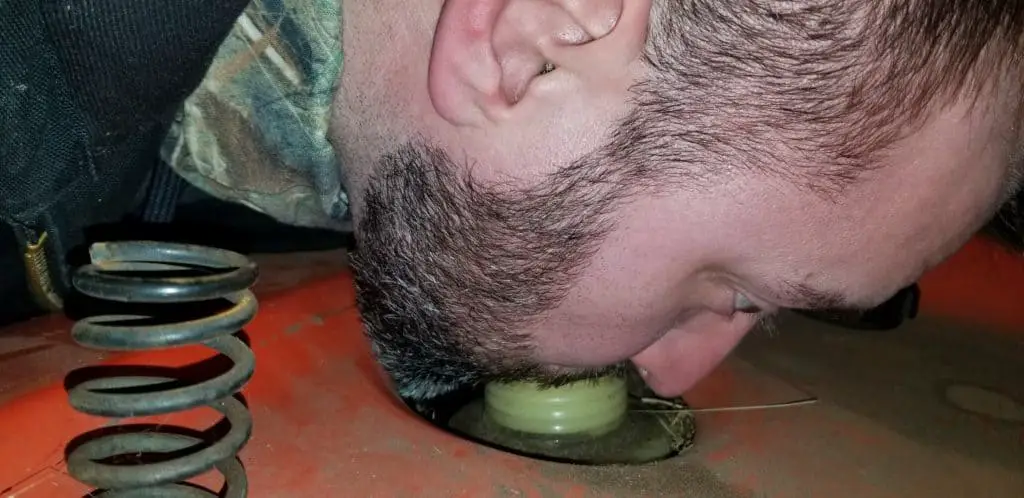
A friendly reminder is to slowly reduce your air pressure going into the tank before you back your face away. If you blow really hard and pull your face back, you’re likely going to get splashed in the face with some gas.
This will push any stubborn air bubbles down the line to where they can eventually vent out through the carburetor.
Do this process until you see a decent amount of fuel in the fuel filter (assuming it’s clear) and then try starting the mower again.
If you’re not seeing any fuel make it to the filter, you can always disconnect the fuel line from the fuel filter and try blowing into the tank again. If no fuel comes out of the hose, then it’s likely clogged from debris.
You can try snaking a relatively flexible wire in the fuel line to see if you can loosen the blockage and try blowing into the tank again.
The second method is to use an air compressor. You don’t want the PSI to be too much when doing this. Probably 20psi or so will be fine and we’ll only be using short 1-2 second bursts.
You can either use this in place of your mouth on the gas tank by placing your hand over the gas tank fill hole and then pushing the air compressor nozzle between your thumb and index finger. Go ahead and give it a few short bursts with a few seconds in between.
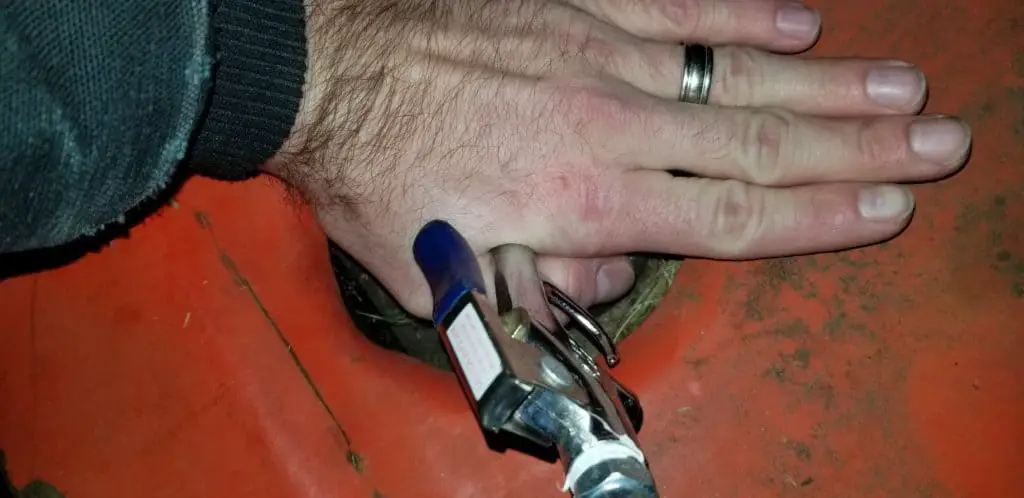
You’re essentially filling the gas tank with excess air, it expands, and as it tries to return to its normal volume the air will displace the liquid and force the liquid gas up the pickup tube and down to the carburetor.
You can also do this process from the opposite end of the lawn tractor. Go ahead and make sure the gas cap is securely on the tank and then remove the fuel line from the fuel pump on the engine. Go ahead and do the same thing where you squirt air into the fuel line for a second or so.

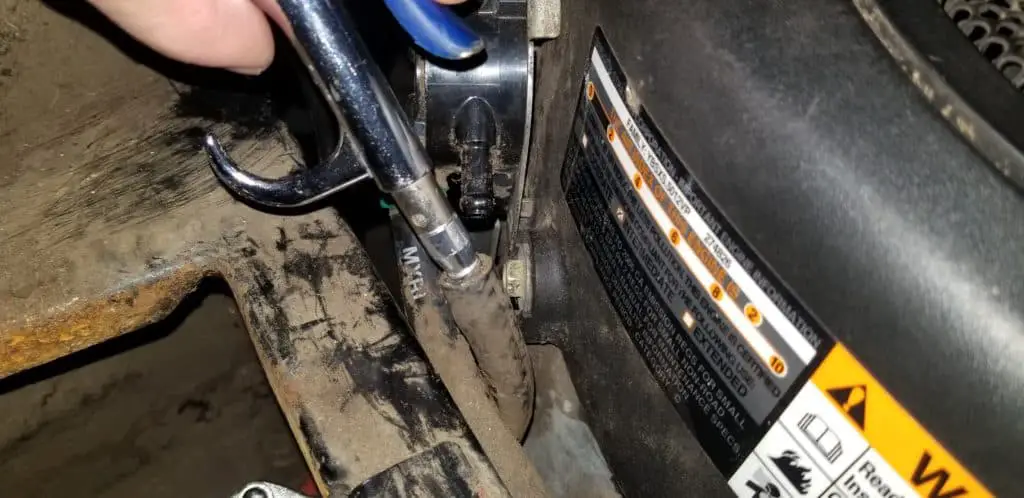
This will drive air pockets back into the gas tank, and as the tank expands and pressurizes, it will displace the liquid gas and force it up the pickup tube and down to your end of the hose.
It might take a few short bursts, but once gas starts flowing out go ahead and immediately hook it back up to the fuel pump and try to start the mower.
